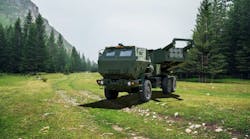U.S. Sends Four HiMARS to Assist Ukraine's Forces
Continuing to assist Ukraine in its war with Russia, the U.S. Department of Defense (DoD) has included four M142 High Mobility Artillery Rocket Systems (HiMARS) as part of a $700 million assistance package to Ukraine. The HiMARS launches as many as six precision-guided rockets or a single missile from a pod carried on a five-ton truck, typically the Family of Medium Tactical Vehicles (FMTVs) used by the U.S. Army.
The assistance package also includes five counter-artillery radar systems, two air-surveillance radars, many anti-armor weapons and artillery rounds, and four Mi-17 helicopters.
The HiMARS (see figure) was developed by Lockheed Martin with assistance from BAE Systems in the late 1990s. It's a smaller, wheeled version of the M270 Multiple Launch Rocket System (MLRS), which has two launch pods and twice the firepower of the single pod in the HiMARS. The systems are designed for interoperability, and the HiMARS can fire the full assortment of MLRS munitions with an accurate target range of approximately 40 miles.
Regarding the HiMARS, it brings mobility and targeting precision to Ukraine, as explained by Colin H. Kahl, undersecretary of defense for policy, during a briefing at the U.S. Pentagon following the announcement of this latest military-aid package to Ukraine: “What the HIMARS will allow them to do is to get greater standoff. Right now, the Howitzers we provided them have about a 30-km range; the HIMARS have more than twice that, which will allow them—even with fewer systems—greater standoff.”
Kahl added that the targeting precision is outstanding: “These are precision-guided systems with extended range. For high-value targets, that allows them to keep some of the pressure off Ukrainian forces on the front. We think these systems will be very useful.”
